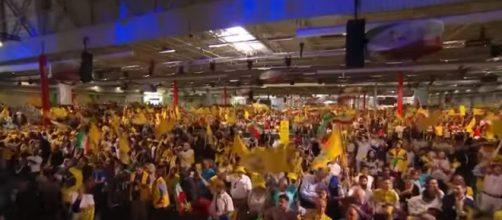The real problem of iran is not the nuclear deal and not even a nuclear bomb; it is the Regime itself. Trump’s new policy marks the beginning of a new era, defined by a U.S. strategy that transcends an Iran narrative focused solely on its nuclear weapons program. Aside from the cacophony of voices, here and abroad, debating the positive or negative implications of that new approach, there are a few indisputable facts about the regime that are at the core of the issue.
The nature of the regime
First, you cannot tame a fiend with regulations or negotiations.
As Newt Gingrich pointed out, “America is today faced with the same choice with Iran that we had in North Korea in 1994. We now know that during 23 years of talking, posturing, and diplomatic maneuvering, the North Koreans simply kept building their nuclear weapon and missile programs.”
It should come as no surprise that this process was repeated in Iran. Even with the JCPOA hanging over their head, the Iranians simply kept developing their advanced missiles and potential nuclear capabilities under the cover of a civilian program controlled by the Islamic Revolutionary Guards Corps (IRGC).
A nuclear weapon contains both a warhead and a delivery system, i.e., a ballistic missile. But major military sites in Iran developing ballistic missiles remain uninspected.
Furthermore, Section T of Annex 1 of the JCPOA explicitly prohibits all “Activities which could contribute to the design and development of a nuclear explosive device.” Yet, Tehran has hampered monitoring of such activities by barring international inspectors from military sites, where the core of the nuclear program exists. The deal perhaps created a semblance of peace, but the regime’s true ambitions eventually reveal themselves. It would be delusional to assume that regulations can effectively change the nature of a corrupt and oppressive regime.
As President Trump said in his policy announcement, “History has shown that the longer we ignore a threat, the more dangerous that threat becomes.” The correct approach, as history will attest, is to “address the full range of Iran's destructive actions” and directly confront the regime.
What Iran has done
Secondly, it is crucial to have a “clear-eyed assessment of the Iranian dictatorship” and to recognize its Human Rights abuses, domestic oppression, sponsorship of terrorism and its “continuing aggression in the Middle East and all around the world.” There are mountains of evidence of the Iranian government’s brutal treatment of its people: the 1988 massacre of as many as 30,000 political prisoners; juvenile executions; political oppression; and barbaric punishments like amputation, Breitbart reports.
The Islamic Revolutionary Guard Corps, “the Iranian Supreme Leader’s corrupt personal terror force and militia,” is the true culprit behind the war in Syria; terrorism and sectarianism in Iraq; and the crisis in Yemen, Lebanon and the Middle East in general.
The National Council of Resistance of Iran – US Representative Office (NCRIUS) has revealed 15 terrorist training camps in Iran responsible for dispatching troops and exporting terrorism all over the world. NCRIUS also disclosed how the IRGC hijacks Iran’s economy and robs the Iranian people to fund proxies abroad.
The very existence of the Iranian regime poses a lethal threat to the safety and welfare of Iran’s people, the U.S. and international security. As President Trump stressed in his speech, “We will not continue down a path whose predictable conclusion is more violence, more terror, and the very real threat of Iran's nuclear breakout.”
The designation of the IRGC as a terrorist organization by the United States Government must be accompanied by sanctions.
Further, the IRGC must be expelled from regional states. It is apparent that “as our case is new, so we must think anew, and act anew.” The new policy towards the Iranian regime should allow no tolerance and no ambiguity.
A new policy should aim at empowering the Iranian people
A new approach should not employ U.S. forces directly against the regime but empower the Iranian people. In 2009 President Obama abandoned Iranian protesters and sided with the regime; today President Trump has sided with the people, “the Iranian regime's longest-suffering victims.” As the President pointed out, the Iranian people “are longing to reclaim their country's proud history, its culture, its civilization, its cooperation with its neighbors.”
According to Fox News, just two days after the speech, thousands of Iranian protesters spoke out against the regime.
Charging corruption and chanting “we don’t want a government of sheikhs,” they voiced their opposition to the ruling regime in its entirety. Some experts say the protesters were emboldened by Trump’s speech. In this age of information, policy can cast a wide net; even a small sign of support can turn a yearning into a revolutionary act. Empowering Iran’s people is the first step towards the establishment of freedom and democracy in Iran.
If politics brings out the worst in people, maybe people can bring out the best. As NCRI President-elect Maryam Rajavi remarked, “It is time that the international community recognizes the aspirations of the Iranian people and stands with the people of Iran and their legitimate right for regime change.”


